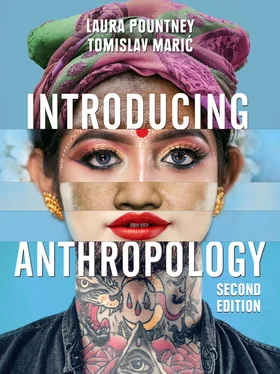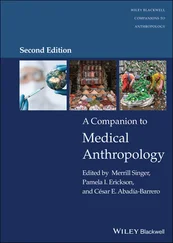Wishcrys: Crystal Abidin https://wishcrys.com
CHAPTER 3The Body
Contents
1 Key issues and debates
2 Body Modifications and Decorations
3 Body modifications
4 Body modification in Western societies
5 Tattooing.
6 Skin colour bias
7 Body Types
8 Body image in Fiji
9 Training the body in sport
10 Ideal male body type, size: Symbolic power
11 Sexy bodies
12 Anthropological Theories of the Body
13 Symbolic Classification and the Body: The Body and Society
14 Handedness
15 Body techniques
16 Habitus
17 The ‘social skin’
18 Conclusion
19 End-of-chapter questions
20 Key terms
21 Personal investigation
22 Suggested further sources
How do humans use bodies to communicate differences between one another?
What are the meanings of body modification and body image?
What are the different anthropological theories about bodies?
How does the body reflect the values and beliefs of the wider society to which it belongs?
Chapter 1explored the ways in which human beings evolved physically and the ways in which their evolved bodies have shaped culture. Anthropologists are also interested in the meanings and values that are attached to the body in different cultural settings. The body plays an important role in how we classify (put into categories) the world around us. This chapter looks at different relationships between the body and society. The body is seen to communicate a range of statuses, ranks and relationships. Bodies can be perceived as things to be beautified, fixed and adorned, and can be recognized, among other things, as male or female, black or white. They may convey national pride, as was the case during the football World Cup in Russia in 2018. Bodies can also communicate the effects of racism, neglect and abuse. Anthropologists have long been interested in ideas about the body. The anthropological literature and number of ethnographies on the body are vast. This chapter looks at some ways in which the body is studied in anthropology.
What should the human body look like?
What exercise should bodies do?
What is the shape of the perfect body? Is it the same for men and women?
Where do ideas of the ‘perfect body’ come from?
What do ideas about the body say about people’s notions of health, culture and identity?
Body Modifications and Decorations
All cultures paint, pierce, tattoo, reshape or decorate their bodies. Humans do not go out naked; they dress or decorate certain parts of their body to present themselves to other humans. Body decorations can communicate a person’s status in society, their identity and the differences between them and others. Body decorations and modification form a visual language through which humans navigate the world in which they live. However, not all cultures share the same values and beliefs, and certain body modificationpractices are often misunderstood or misinterpreted, even within the same culture.
In both the past and the present, the body has been reshaped in many culturally relevant ways, from traditional foot-binding in China to more recent cosmetic surgeries in Western society. Humans modify their bodies for many reasons. Some religious traditions believe that marking the body is a corruption of the perfect human form designed by God, while many others consider the undecorated body to be not fully human. For some, body decoration is something that distinguishes humans from the animal world or from other humans in different cultures.
The body can be either temporarily modified (for example, body-painting, make-up, toiletries, hairstyles) or permanently modified (tattooing, scarification, reshaping and piercing). Below are three examples of body modification in different cultures and different times.
body modificationThe deliberate altering of the human anatomy
The foot-binding of girls was practised only in China and became popular in the twelfth century among the elite. Its purpose was to restrict the growth of the foot as a sign of beauty, wealth and discipline. A woman with bound feet could not walk properly. She was also considered attractive as a marriage partner because her physical impairment indicated she was honourable and a virgin. Foot-binding began at 3–6 years of age, when all the girl’s toes, apart from the big toe, were folded down under the sole of the foot and bandaged tightly in that position. The bones of the toes broke and the instep was artificially curved and raised in an attempt to create the ‘lotus foot’, the perfect arch of the foot. Women with these modifications would need constant support to stand, and walking was extremely painful and problematic in terms of balance. Men found women with bound feet very attractive. Foot-binding was officially banned in China in 1911.
Lip plates are worn in parts of Africa and South and Northwest America. The Kayapo men of Brazil still wear lip plates, though it is best known as a practice among the women of certain African cultures. A hole is sliced into the lower lip and a small object is inserted. After the hole heals around the object, it is removed and is replaced by a larger plate, gradually stretching the hole. The purpose and meaning of lip plates is different in different cultures. The Lobi women of the Ivory Coast and Ghana wear lip plates to protect against evil spirits that enter the body via the mouth. For others, they are a status symbol. Later in this chapter, Terence Turner explains the meaning of lip plates for Kayapo men (see p. 75).
Scarification is a way of permanently marking the body by cutting the skin and is often carried out as part of a ritual. Scarification was, and is still today, practised most widely in Africa and among Australian Aboriginal people. The main point of African scarification is to beautify, although scars of a certain type, size and position on the body often indicate group identity or stages in a person’s life. Among the Dinka of Sudan, facial scarification, usually around the temple area, is used for clan identification. In southern Sudan, Nuba girls traditionally receive marks on their forehead, chest and abdomen at the beginning of puberty. At first menstruation they receive a second set of cuts, this time under the breasts. These are enlarged by a final, extensive phase of scarring after the weaning of the first child, resulting in designs stretching across the sternum, back, buttocks, neck and legs. Nuba scarification is determined by social status and maturity and is perceived as a mark of beauty. In the context of the cultural traditions of the Dinka and Nuba, the individual has little choice in the matter of scarification.
In other parts of Africa, scarification is carried out for different reasons. Pain and blood can play a large part in the scarification process, determining a person’s fitness, endurance and bravery. This is especially the case in puberty rites, since a child must prove a readiness to face the responsibilities of adulthood, in particular the prospect of injury or death in battle for men and the trauma of childbirth for women. However, traditional scarification has declined in Africa, Australia and elsewhere as a result of health concerns and politico-cultural changes.
Читать дальше












